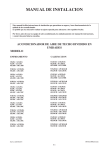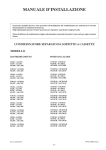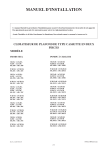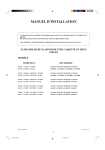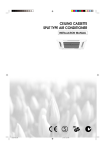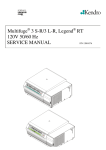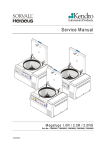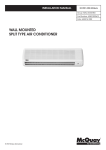Download Acson Air Conditioner Installation manual
Transcript
INSTALLATION MANUAL Model: IM-CKA-0501-ACSON CEILING CASSETTE SPLIT TYPE AIR CONDITIONER (A Series) CEILING CASSETTE OUTLINE AND DIMENSIONS Indoor Unit (CKA Series) • (With Wireless Remote Control & With Wired Remote Control) B F C D E J I G A H M All dimensions are in mm / (in) MODEL A B C D E F G H I J K CK / 5CK 20A/AR CK / 5CK 25A/AR CK / 5CK 30A/AR CK 40A/AR 820 820 363 335 28 930 930 642 622 555 555 (32,2) (32,2) (14,3) (13,2) (1,1) (36,6) (36,6) (25,2) (24,5) (21,9) (21,9) CK 50A/AR i Outdoor Unit (SL - B Series) 39 (1,5) 840 (33,1) 124 (4,9) 592 (23,3) 840 (33,1) 124 (4,9) 5 (0,2) 297 (11,7) 330 (13,0) 160 (6,3) 85 A B C D E F G H 840 646 330 297 309 626 41 (33,1) (25,4) (13,0) (11,7) (12,2) (24,6) (1,6) ii 85 (3,3) J K 75 (3,0) 177 (7,0) 106 (4,2) L M N P (2,6) (3,0) 65 75 20 (0,8) 177 (7,0) 626 (24,6) 646 (25,4) 20 (0,8) 309 (12,2) 20 (0,8) Dimension 20B / 20BR 25B / 25BR 30B / 30BR 141 (5,6) 2,5 (0,1) (3,3) 41 (1,6) 78,5 (3,1) 5 (0,2) 39 (1,5) 408 (16,1) 378 (14,9) 330 (13,0) 15 (0,6) 15 (0,6) All dimensions are in mm / (in) Q R 106 408 378 124 592 78,5 (4,2) (16,1) (14,9) (4,9) (23,3) (3,1) Outdoor Unit : SL20C / 25C / 28C & CR K L All dimensions are in mm / (in) P N C M N L G H S T B FOR SL25C/CR ONLY E F Q C A D O R I Dimension A B C D E J F G H I J K L M N O 20C/CR 855 628 (33,7) (24,7) 328 508 181 (12,9) (20,0) (7,1) 44 (1,7) 93 (3,7) 149 (5,9) 101 (4,0) 113 (4,4) 603 (23,7) 126 (5,0) 164 (6,4) 17 (0,7) 49 (1,9) 25C/CR 28C/CR 855 730 (33,7) (28,7) 328 513 182 (12,9) (20,2) (7,2) 44 (1,7) 93 (3,7) 149 (5,9) 101 (4,0) 113 (4,4) 603 (23,7) 126 (5,0) 164 (6,4) 17 (0,7) 47 (1,9) Dimension P Q R S T 20C/CR 32 (1,3) 3 (0,1) 23 (0,9) 73 (2,9) 75 (3,0) 25C/CR 28C/CR 32 (1,3) 3 (0,1) 23 (0,9) 73 (2,9) 75 (3,0) Outdoor Unit : SL30C / 40C / 50C & CR 141,5 (5,6) All dimensions are in mm / (in) 20,0 (0,8) 746,5 (29,4) 448,0 (17,6) 141,5 (5,6) 850,0 (33,5) 20,0 (0,8) 1030,0 (40,6) 25,0 (1,0) 50,0 (2,0) 85,0 (3,3) iii 40,0 (1,6) 400,0 (15,7) 320,0 (12,6) 40,0 (1,6) Sharp edges and coil surfaces are potential locations which may cause injury hazards. Avoid from being in contact with these places. ! Caution ! Avertissement Les bords coupants et les surfaces du refroidisseur tuulaire présentent un risque de blessure. Mieux vaut éviter le contact avec ces endroits. ! Vorsicht Scharfe Kanten und Wärmetauscherflächen stellen eine Gefahrenquelle dar. Jeglicher Kontakt mit diesen Stellen ist zu vermeiden. ! Cautela Per preservarsi da eventuali ferite, evitare di toccare gli spigoli afilati e la superficie dei serpentini. Los Bordes afilados y la superficie del serpentín pueden producir lesiones. Evite tocarlos. ! Cuidado ! Осторожно Острые края и поверхности змеевиков являются потенциальными местами нанесения травм. Остерегайтесь контакта с этими местами. NOTICE This product is subjected to Waste of Electrical and Electronic Equipment Regulations (WEEE Regulations). The waste product shall be separately collected by specific collection and treatment centre. Please refer to local authorithy for these centres. This is only applicable to European Union countries. Ce produit est soumis à la ré échets des é électriques et électroniques (ré r échet doit être collecté t séparé r ment par un centre de collecte et de traitement spécifique. Veuillez vous ré r fé f és locales pour connaî aître ces centres. Ceci éenne. Dieses Produkt unterliegt den Bestimmungen zur Entsorgung von elektrischen und elektronischen Gerää ä ätes getrennt vom Hausmüll bei Ihrer örtlichen Mü ö äändiges Abfall-Amt. Dieser Hinweis gilt nur fü f r Länder ä der Europäischen Union. Questo prodotto è soggetto alle disposizioni RAEE (Rifiuti di apparecchiature elettriche ed elettroniche). à ritirato da un centro incaricato del ritiro e smaltimento. Per conoscere il nome del centro pertinente, contattare le autoritàà locali. Questa disposizione è valida solamente i paesi dell’U.E. éctrico y Electrónico en materia de í ífico ñado será de colecció í ón Europea. данного по и . правила , Европейского iv . Эти . English INSTALLATION MANUAL This manual provides the procedures of installation to ensure a safe and good standard of operation for the air conditioner unit. Special adjustment may be necessary to suit local requirements. Before using your air conditioner, please read this instruction manual carefully and keep it for future reference. CEILING CASSETTE SPLIT TYPE AIR CONDITIONER MODEL COOLING ONLY HEAT PUMP CK20A / ACK20A SL20C / ALC20C 4SL20B / A4LC20B CK20AR / ACK20AR SL20CR / ALC20CR 4SL20BR / A4LC20BR 5CK20A / A5CK20A 5SL20C / A5LC20C 5CK20AR / A5CK20AR 5SL20CR / A5LC20CR CK25A / ACK25A SL25C / ALC25C 4SL25B / A4LC25B CK25AR / ACK25AR SL25CR / ALC25CR 4SL25BR / A4LC25BR 5CK25A / A5CK25A 5SL25C / A5LC25C 5CK25AR / A5CK25AR 5SL25CR / A5LC25CR CK30A / ACK30A SL28C / ALC28C SL30C / ALC30C 4SL30C / A4LC30C CK30AR / ACK30AR SL28CR / ALC28CR SL30CR / ALC30CR 4SL30CR / A4LC30CR 5CK30A / A5CK30A 5SL28C / A5LC28C 5SL30C / A5LC35C 5CK30AR /A5CK30AR 5SL28CR / A5LC28CR 5SL30CR / A5LC35CR CK40A / ACK40A SL40C / ALC40C 4SL40C / A4LC40C CK40AR / ACK40AR SL40CR / ALC40CR 4SL40CR / A4LC40CR 5CK40A / A5CK40A 5LC35C / A5LC35C 5SL40C / A5LC40C 5CK40AR / A5CK40AR 5LC35CR / A5LC35CR 5SL40CR / A5LC40CR CK50A /ACK50A SL50C / ALC50C 4SL50C / A4LC50C CK50AR / ACK50AR SL50CR / ALC50CR 4SL50CR / A4LC50CR 5CK50A / A5CK50A 5SL50C / A5LC50C 5CK50AR / A5CK50AR 5SL50CR / A5SL50CR IM-CKA-0501(2)-Acson Part No.:A08019025475 1-1 CONTENTS - Outline And Dimensions - Safety Precautions - Installation Diagram - Installation Of The Indoor Unit - Installation Of The Outdoor Unit - Refrigerant Piping Work - Electrical Wiring Connection - Special Precautions When Dealing With R410A Unit - Special Precautions When Dealing With R407C Unit - Vacuuming And Charging - Special Precautions When Charging Unit With Copeland Scroll Compressors - Accessory Parts - Indicator Lights - Overall Checking - Standard Operation Conditions - Auto Random Re-start Function - Service And Maintenance - Troubleshooting - Phase Sequencer (Optional) page i – iv page 2 page 3 page 4 page 6 page 7 page 8 page 11 page 11 page 11 page page page page page page page page page SAFETY PRECAUTIONS Before installing the air conditioner unit, please read the following safety precautions carefully. ! Warning • Installation and maintenance should be performed by qualified persons who are familiar with local code and regulation, and experienced with this type of appliance. • All field wiring must be installed in accordance with the national wiring regulation. • Ensure that the rated voltage of the unit corresponds to that of the name plate before commencing wiring work according to the wiring diagram. • The unit must be GROUNDED to prevent possible hazard due to insulation failure. • All electrical wiring must not touch the refrigerant piping or any moving parts of the fan motors. • Confirm that the unit has been switched OFF before installing or servicing the unit. ! Caution Please take note of the following important points when installing. • Do not install the unit where leakage of flammable gas may occur. If gas leaks and accumulates around the unit, it may cause fire ignition. • Ensure that the drainage piping is connected properly. If the drainage piping is not connected properly, it may cause water leakage which will dampen the furniture. • Do not overcharge the unit. This unit is factory pre-charged. Overcharge will cause over-current or damage to the compressor. • Ensure that the units panel is closed after service or installation. Unsecured panels will cause the unit to operate noisily. 1-2 12 13 13 14 15 15 15 16 16 INSTALLATION DIAGRAM English Wireless Remote Control Drain Hose Indoor unit Air Discharge Louver IR Receiver LED Light Front Panel Air Intake Grille Air Filter (behind the grille) Air Discharge Louver Remote Control Refrigerant Piping Air Intake Air Intake Outdoor unit Air Discharge Wired Remote Control Drain Hose Indoor unit Air Discharge Louver Front Panel Air Intake Grille Air Filter (behind the grille) Air Discharge Louver Remote Control Refrigerant Piping Air Intake Air Intake Outdoor unit Air Discharge 1-3 INSTALLATION OF THE INDOOR UNIT Preliminary Site Survey • Electrical supply and installation is to conform to local authority's (e.g. National Electrical Board) codes and regulations. • Voltage supply fluctuation must not exceed +10% of rated voltage. Electricity supply lines must be independent of welding transformers which can cause high supply fluctuation. • Ensure that the location is convenient for wiring, piping and drainage. • The indoor unit must be installed in such that is free from any obstacles in path of cool air discharge and warm air return, and must allow spreading of air throughout the room (near the center of the room). Min. 0.5 m Min. 0.5 m Max. 0.3 m Max. 3.0 m Min. 1.0 m Beam • Must be provide clearance for the indoor unit from the wall and obstacles as shown in the figure. Min. 0.5 m Obstacle Floor • The installation place must be strong enough to support a load 4 times the indoor unit weight to avoid amplifying noise and vibration. • The installation place (hanging ceiling surface) must be assuring levelness and the height in the ceiling is 350mm or more. • The indoor unit must be away from heat and steam sources (avoid installing it near an entrance). Unit Installation • Measure and mark the position for the hanging rod. Drill the hole for the angle nut on the ceiling and fix the hanging rod. 890.0 mm (Ceiling board opening) 790.0 mm (Hanging rod) 890.0 mm (Ceiling board opening) Unit Unit size 820.0mm Unit size 820.0 mm 620.5 mm (Hanging rod) • The installation template is extended according to temperature and humidity. Check on dimensions in use. • The dimensions of the installation template are the same as those of the ceiling opening dimensions. • Before ceiling laminating work is completed, be sure to fit the installation template to the indoor unit. NOTE Be sure to discuss the ceiling drilling work with the installers concerned. Piping Direction Unit Hanging • Confirm the pitch of the hanging rod is 790mm × 620.5mm sharp. • Hold the unit and hang it on the hanging rod with the nut and washer. • Adjust the unit height to 35.0 mm between the indoor unit bottom surface and the ceiling surface. Indoor Unit Ceiling Board 35.0 mm • Confirm with a level gauge that the unit is installed horizontally and tighten the nut and bolt to prevent unit falling and vibration. • Open the ceiling board along the outer edge of the paper installation template. 1-4 Drain Piping Work • Avoid installing the drain pipe in up and down slope to prevent reversed water flow. • During the drain pipe connection, be careful not to exert extra force on the drain connector at indoor unit. Indoor Unit • The outside diameter of the drain connection at the flexible drain hose is 20mm. Pipe Clamp Good Bad • Be sure to execute heat insulation (polyethylene foam with thickness more than 8.0mm) on the drain piping to avoid the condensed water dripping inside the room. Drain Test • Connect the main drain pipe to the flexible drain hose. Feed Water • Feed water from flexible drain hose to check the piping for leakage. Main Drain Pipe • When the test is completed, connect the flexible drain hose to the drain connector on the indoor unit. Flexible Drain Hose NOTE This Indoor Unit uses a drain pump for condensed water drainage. Install the unit horizontally to prevent water leakage or condensation around the air outlet. Panel Installation • The front panel can only be fitted in one direction, follow the piping direction. (Follow piping arrow sticker on front panel) • Be sure to remove the installation template before installing the front panel. Open Screw • Open the air intake grille by pulling back the catchers and removing it together with filter from panel. • Install the front frame panel onto the indoor unit by 4 screws and tighten it completely to prevent cool air leakage. • Connect the LED wire and air swing wire to the indoor unit. Control Box LED Wire From Front Panel Air Swing Wire 1-5 English • Drain pipe must be in downward gradient for smooth drainage. NOTE Install the front frame panel firmly to prevent cool air leakage which will cause condensation and water dripping. Indoor Unit Cool Air Cool Air Air Leak Air Leak Ceiling Board Ceiling Board Panel Panel Bad Installation Good Installation Air intake grille installation Frame (Optional Item) • Before installing the air intake grille, be sure to fix the ionizer filter to the air filter. • Install the air intake grille together with the air filter to the front panel. Ionizer Filter (Optional Item) • The grille can be fit in any direction, when selecting direction, the ceiling design and grille operability should be considered. • If the unit comes with ionizer filter (optional item), make sure to fix the ionizer filter to the air filter before installing the air intake grille. Filter (Standard) • Fix the ionizer filter to the air filter with the black side on top and white side at bottom. • Carefully clip on the ionizer filter frame. INSTALLATION OF THE OUTDOOR UNIT Preliminary site survey • A place protected from rain, direct sunlight and well-ventilated wherever practicable. • A place capable of bearing the weight of the outdoor unit and isolating noise and vibration. • A place where there are no obstruction of air flow into or out the unit. • Do not put any object which may become obstacle for the air flow into or out the outdoor unit. • The location must not be susceptible to high concentration dust, oil, salt or sulfide gas. Outdoor unit installation • Install the outdoor unit firmly and horizontally. Maintain a space clearance from the obstruction as shown in below for servicing and air ventilation. A B C D SL series A B C D Min. distance (mm) 300 1000 300 500 1-6 Refrigerant piping is important in particular. Refrigeration cycle of the split air conditioner is realized by the perfect piping work. Piping length and elevation If the piping is too long, both the capacity and reliability of unit will drop. As the number of bends increase, resistance to flow of refrigerant system increases, thus lowering cooling capacity and as a result the compressor may become defective. Always choose the shortest path and follow the recommendation as tabulated below. Model Max. length (m) Max. elevation (m) Max. no. of bends Liquid pipe size Gas pipe size Model Max. length (m) Max. elevation (m) Max. no. of bends Liquid pipe size Gas pipe size 4SL20B/BR SL20C/CR 4SL25B/BR SL25/28C/CR 15 15 8 8 10 10 1/4” 3/8” 5/8” 5/8” 5SL20C/CR 15 8 10 1/4” 1/2” 5SL25C/CR 15 8 10 1/4” 5/8” SL30C/CR 35 10 10 3/8” 5/8” SL40C/50C/CR 35 10 10 3/8” 3/4” 5SL28C/CR 15 8 10 3/8” 5/8” 5SL35/40/50C/CR 35 10 10 3/8” 5/8” Piping Connection • Do not use contaminated or damaged copper tubing. If any piping, evaporator or condenser had been exposed or had been opened for 15 seconds or more, then vacuum and purge with field supplied refrigerant. Generally, do not remove plastic, rubber plugs and brass nuts from the valves, fittings, tubing and coils until it is ready to connect suction or liquid line into valves or fittings. • If any brazing work is required, ensure that nitrogen gas is passed through coil and joints while the brazing work is being done. This will eliminate soot formation on the inside wall of copper tubings. • Cut the pipe stages by stages, advancing the blade of pipe cutter slowly. Extra force and a deep cut will cause more distortion of pipe and therefore extra burr. • Remove burrs from cut edges of pipes with a remover. This will avoid unevenness on the flare face which will cause gas leak. • Align the center of the piping and sufficiently tighten the flare nut with fingers. Finally, tighten the flare nut with torque wrench until the wrench clicks. • Be sure to execute heat insulation. (polyurethane form with thickness more than 15 mm) • Except the outdoor unit which is pre-charge with refrigerant R22, the indoor unit and the refrigerant connection pipes must be purged because the air that contain moisture remaining in the refrigerant cycle may cause malfunction to the compressor. 1-7 English REFRIGERANT PIPING WORK Additional Charge (In gram) The refrigerant is pre-charge in the outdoor unit, but additional charge of refrigerant after vacuuming is necessary. Follow the recommendation as tabulated below. Cooling Only (R22) CK20A CK25A CK30A/40A/50A Heatpump (R22) 10m 40 90 120 15m 20m 25m 30m 35m 110 270 380 640 900 1150 1410 CK20AR CK25AR CK30AR/40AR/50AR Cooling Only (R407C) CK20A CK25A CK30A/40A/50A 10m 40 80 120 10m 40 90 90 15m 20m 25m 30m 35m 110 270 280 460 650 830 1020 10m 40 80 80 15m 20m 25m 30m 35m 110 260 260 430 610 780 960 Heatpump (R407C) 15m 20m 25m 30m 35m 110 260 360 600 840 1090 1330 CK20AR CK25AR CK30AR/40AR/50AR Cooling & Heatpump (R410A) 5CK20/25A/AR 5CK30/40/50A/AR 10m 15m 20m 25m 30m 35m 30 100 80 230 390 550 710 870 ELECTRICAL WIRING CONNECTION Cooling Only IMPORTANT: * These values are for information only. They should be checked and selected to comply with local and/or national codes and regulations. They are also subject to the type of installation and size of conductors. ** The appropriate voltage range should be checked with label data on the unit. ETL listed is only applicable to 60Hz power supply only. CK20A / CK25A & CK30A Model Indoor CK20A CK25A CK30A Outdoor SL20B/20C SL25B/25C SL28C/30C Voltage range** 220-240V/1Ph/50Hz + ! or 208-230V/1Ph/60Hz+ ! Recommended fuse* (A) 16 20 25 Power supply cable size* (mm2) 2.5 2.5 4.0 Number of conductors 3 3 3 2.5 2.5 2.5 Interconnection cable size* (mm2) Number of conductors 3 3 4 CK20A / 25A <> SL20B / 25B / 20C / 25C CK30A <> SL28C Interconnection Cable COMP COMP L Indoor Unit Terminal Block N N N Power Supply Cable CK30A <> SL30C COMP ! There must be a double pole switch with minimum 3mm contact gap and fuse/circuit breaker as recommended in the fixed installation circuit. Interconnection Cable L Indoor Unit Terminal Block COMP L N N N L ! Outdoor Unit Terminal Block Power Supply Cable There must be a double pole switch with minimum 3mm contact gap and fuse/circuit breaker as recommended in the fixed installation circuit. 1-8 N Outdoor Unit Terminal Block Indoor Outdoor Model 5CK30/40A CK40A CK50A 5SL35C SL40C SL50C 380-420V/3Ph /50Hz+ N+ ! or 208-230V/3Ph/60Hz+N+ ! 10/20 16/25 1.5/2.5 2.5/4.0 5 5 1.5/1.5 1.5/1.5 4 4 Voltage range** Recommended fuse* (A) Power supply cable size* (mm2) (50/60Hz) Number of conductors Interconnection cable size* (mm2) (50/60Hz) Number of conductors CK40A / CK50A <> SL40C / SL50C COMP L N COMP Indoor Unit Terminal Block L R Interconnection Cable N S Outdoor Unit Terminal Block T N ! There must be a double pole switch with minimum 3mm contact gap and fuse/circuit breaker as recommended in the fixed installation circuit. Power Supply Cable Heat Pump IMPORTANT : * These values are for information only. They should be checked and selected to comply with local and/or national codes and regulations. They are also subject to the type of installation and size of conductors. ** The appropriate voltage range should be checked with label data on the unit. CK20AR / CK25AR / CK30AR Model Indoor Outdoor CK20AR CK25AR CK30AR SL20BR/20CR SL25BR/25CR SL28CR/30CR 220-240V/1Ph/50Hz+ ! or 208-230V/1Ph/60Hz+ ! 16 20 25 2.5 2.5 4.0 3 3 3 2.5 2.5 2.5 5 5 6 Voltage range** Recommended fuse* (A) Power supply cable size* (mm2) Number of conductors Interconnection cable size* (mm2) Number of conductors CK20AR / 25AR <> SL20BR / 25BR SL20CR / 25CR Outdoor Coil Sensor 4WV OF Indoor Unit Terminal Block Interconnection Cable COMP 4V OF COMP L N1 N2 N Power Supply Cable ! 1-9 Outdoor Unit Terminal Block There must be a double pole switch with minimum 3mm contact gap and fuse/circuit breaker as recommended in the fixed installation circuit. English CK40A & CK50A Outdoor Coil Sensor CK30AR <> SL28CR 4WV A Interconnection Cable 4WV Indoor Unit Terminal Block OF COMP OF COMP Outdoor Unit Terminal Block N L N Power Supply Cable L N E N ! There must be a double pole switch with minimum 3mm contact gap and fuse/circuit breaker as recommended in the fixed installation circuit. Outdoor Coil Sensor CK30AR <> SL30CR A A Interconnection Cable 4WV Indoor Unit Terminal Block 4WV OF OF COMP COMP L L N N Outdoor Unit Terminal Block N L ! L N E There must be a double pole switch with minimum 3mm contact gap and fuse/circuit breaker as recommended in the fixed installation circuit. N CK40AR & CK50AR Model Indoor Outdoor Voltage range** Recommended fuse* (A) Power supply cable size* (mm2) Number of conductors Interconnection cable size* (mm2) Number of conductors 5CK30/40AR CK40AR CK50AR 5SL35CR SL40CR SL50CR 380-420V/3Ph/50Hz +N+ ! or 208-230V/3Ph/60Hz+N+ ! 10/20 16/25 1.5/2.5 2.5/4.0 5 5 1.5/1.5 1.5/1.5 7 7 Outdoor Coil Sensor CK40AR / CK50AR <> SL40CR / SL50CR A 4WV OF COMP L A 4WV OF Indoor Unit Terminal Block ! COMP L N Interconnection Cable N Outdoor Unit Terminal R S T N Power Supply Cable There must be a double pole switch with minimum 3mm contact gap and fuse/circuit breaker as recommended in the fixed installation circuit. 1-10 R410A is a new HFC refrigerant which does not damage the ozone layer. The working pressure of this new refrigerant is 1.6 times higher than conventional refrigerant (R22), thus proper installation / servicing is essential. • Never use refrigerant other than R410A in an air conditioner which designed to operate with R410A. • POE oil is used as lubricant for R410A compressor, which is different from the mineral oil used for R22 compressor. During installation or servicing, extra precaution must be taken not to expose the R410A system too long to moist air. Residual POE oil in the piping and components can absorb moisture from the air. • To prevent mischarging, the diameter of the service port on the flare valve is different from that of R22. • • • • Use tools and materials exclusively for refrigerant R410A. Tools exclusively for R410A are manifold valve, charging hose, pressure gauge, gas leak detector, flare tools, torque wrench, vacuum pump and refrigerant cylinder. As an R410A air conditioner incurs higher pressure than R22 units, it is essential to choose the copper pipes correctly. Never use copper pipes thinner than 0.8mm even though they are available in the market. If the refrigerant gas leakage occurs during installation / servicing, be sure to ventilate fully. If the refrigerant gas comes into contact with fire, a poisonous gas may occur. When installing or removing an air conditioner, do not allow air or moisture to remain in the refrigerant cycle. SPECIAL PRECAUTIONS WHEN DEALING WITH R407C UNIT • • • R407C is a zeotropic refrigerant mixture which has zero ozone depletion potential and thus conformed to the Montreal Protocol regulation. It requires Polyol ester oil (POE) oil for its compressor's lubricant. Its refrigerant capacity and performance are about the same as the refrigerant R22. POE oil is used as lubricant for R407C compressor, which is different from the mineral oil used for R22 compressor. During installation or servicing, extra precaution must be taken not to expose the R407C system too long to moist air. Residual POE oil in the piping and components can absorb moisture from the air. Refrigerant R407C is more easily affected by dust of moisture compared with R22, make sure to temporarily cover the ends of the tubing prior to installation. • • • • No additional charge of compressor oil is permitted. No other refrigerant other than R407C. Tools specifically for R407C only (must not be used for R22 or other refrigerant). i) Manifold gauge and charging hose ii) Gas leak detector iii) Refrigerant cylinder/charging cylinder iv) Vacuum pump c/w adapter v) Flare tools vi) Refrigerant recovery machine Filter-dryer must be installed along the liquid line for all R407C air conditioners. This is to minimise the contamination of moisture and dirt in the refrigerant system. Filterdryer must be of molecular sieve type. For a heat-pump system, install a two-way flow filter dryer along the liquid line. VACUUMING AND CHARGING Vacuuming is necessary to eliminate all moisture and air from the system. The series II Outdoor Unit is provided with flare valve fittings. Vacuuming Charging Before vacuuming, perform leak check for refrigeration circuit. After the system piping are properly connected, connect the flexible hoses to the correct charging nipples as shown in the diagram. Ensure that flexible hose from charging nipples are connected to the vacuum pump via standard servicing valves and pressure gauges (gauge manifold). Vacuum the air conditioner system to at least 500 microns Hg. Do not start the unit when the system is engaged in vacuuming. Before charging, the vacuum must be held at 500 microns Hg for at least 15 minutes, then break vacuum by charging R-22 refrigerant. Operate the unit for 15 minutes and ensure the refrigerant charges is of correct by monitoring running current, gas and liquid line pressures. Suction and discharge pipe pressure should be in the region of 75 psig and 275 psig generally. After ensuring the system is correctly charged, remove flexible hose from charging nipples and replace caps. 1-11 English SPECIAL PRECAUTIONS WHEN DEALING WITH R410A UNIT SPECIAL PRECAUTIONS WHEN CHARGING UNIT WITH COPELAND SCROLL COMPRESSORS These precautions are intended for use with Copeland Scroll compressors only with R22, R407C, R134A, R404A, R507 and R410A refrigerants but are not applied to Copeland reciprocating compressors or competitive Scroll compressors. Scroll compressors have a very high volumetric efficiency and quickly pump a deep vacuum if there is insufficient refrigerant in the system or if refrigerant is added too slowly. Operation with low suction pressure will quickly lead to very high discharge temperatures. While this process is happening, the scrolls are not being well lubricated – scrolls depend on the oil mist in the refrigerant for lubrication. A lack of lubrication leads to high friction between the scroll flanks and tips and generates additional heat. The combination of heat of compression and heat from increased friction is concentrated in a small localized discharge area where temperatures can quickly rise to more than 300˚C. These extreme temperatures damage the Scroll spirals and the orbiting Scroll bearing. This damage can occur in less than one minute especially on larger compressors. Failure may occur in the first few hours or the damage done during field charging may show up some time later. Other typical field charging problems include undercharging, overcharging, moisture or air in the system etc. In time each one of these problems can cause compressor failure. Minimal equipment is required for field charging. The minimum equipment required to do a satisfactory job is:Set of service gauges Vacuum gauge Hoses Scales Vacuum pump Thermometer The proper refrigerant charge should follow the volume as recommended by manufacturer and recommendation should be followed by the installer. 1. Charging procedures – Single phase compressors Evacuate the system to 500 microns Hg. (67Pa). To reduce evacuation time, use short, large diameter hoses and connect to unrestricted service ports on the system. Quality of vacuum cannot be determined by time – a reliable vacuum gauge must be used. (etc. electronic vacuum gauge) Turn the refrigerant cylinder upside down, purge the charging hose and charge liquid through the liquid line charging port until refrigerant no longer flows or until the correct charge has been weighed in. If additional charge is required start the system and slowly bleed liquid into the suction side until the system is full. Copeland recommends charging liquid in a CONTROLLED manner into the suction side until the system is full. This recommendation does not hold true for reciprocating compressors where liquid charging into the suction side could cause severe damage. Carefully monitor the suction and discharge pressures – ensure that the suction pressure does not fall below 25 psig (1.7 bar) at any time during the charging process. ! Caution • A Manifold Gauge will show cylinder pressure rather than suction pressure if the cylinder valve and Manifold valve “A” are both open. There are many ways of charging liquid in a “controlled manner” into the suction side:1. Use valve A on the manifold gauge set 2. Use the valve on the refrigerant cylinder 3. Charge through a Shredder valve 4. Use a hose with a Shredder valve depressor 5. Charge into the suction side at some distance from the compressor 6. All of the above 2. Charging procedures – Three phase compressors The fundamental procedure is the same as for single phase models but the compressor can run in the wrong direction on starting. If this happens reverse any two phases and start again. Short term reverse rotation will not damage the compressor. All Specter compressors (Model: ZR90 to ZR19M) have internal discharge temperature protectors which are very effective in preventing dangerously high discharge temperatures during charging. The protection module will trip and lock the compressor out for 30 minutes. It is not normally necessary to wait 30 minutes for the module to reset. When the compressor has cooled down the module can be reset by breaking the power supply to the control circuit. Very often the serviceman does not understand why the module tripped and uses a jumper wire to bypass it. He continues to charge the system and removes the jumper when charging is complete. The compressor may or may not run with the protector back in the circuit but it is certain that the compressor has been damaged and premature failure is inevitable. 1-12 ACCESSORY PARTS • The indoor unit is provided with air discharge and air intake “knock-out” hole for duct connection. However the connection of the short duct for air discharge is possible on only one side. • The use of short duct for air discharge will improve airflow distribution if there is an obstruction (such as a lighting fixture) or in a long, narrow room or an L-shaped room. It also use for air conditioning of two rooms simultaneously. Possible Direction For Air Discharge And Air Intake Air Discharge Possible Opening Dimension For Duct Connection Air Discharge PCD Ø140 50 50 50 50 50 10 20 10 20 70 90 Ø100 115 Air Discharge Air Intake Air Discharge Knock Out Hole Air Discharge 109 20 119 115 Air Intake Knock Out Hole NOTE • Avoid using the short duct on which the air discharge grille can be completely closed, to prevent evaporator freezing. • In order to prevent condensation forming, be sure that there is sufficient thermal insulation and no leakage of cool air when installing the short duct. • Keep the introduction of fresh air intake within 20% of total air flow. Also provide a chamber and use a booster fan. Sealing Material • It is possible to seal one of the four air discharge outlet. (sealing two or more air discharge outlet could cause a malfunction) • Remove the front panel and insert the sealing material into the air discharge outlet on the indoor unit to seal the air outlet. • The sealing material is the same length as the longer air discharge outlet. If it is desired to seal the shorter air discharge outlet, cut the sealing material to shorten it. • Push the sealing material in about 10 mm beyond the bottom surface of the indoor unit so that it does not touch the air louver. Be sure not to push the sealing material in any farther than about 10 mm. INDICATOR LIGHTS Remote Control When there is infrared remote control operating signal, the signal receiver on indoor unit will made a <beep> for signal acceptance confirmation. 1-13 English Short Duct Specification LED POWER Blink 1 time Blink 2 times Blink 3 times TIMER - SLEEP/HEAT - - Blink 1 time - - Blink 3 times Blink 2 times - Other LEDs Blink Fan Blink Dry & Fan Blink Dry Faulty Indication Room Sensor Open or Short Indoor Coil Sensor Open Outdoor Coil Sensor Open Compressor Overload / Blink Cool Indoor Coil Sensor Short / Outdoor Coil Sensor Short Blink Cool & Dry Gas Leak Blink Cool & Fan Water Pump Fault Action Call Your Dealer OVERALL CHECKING • Ensure that :1) The unit has been mounted solidly and rigid in position. 2) Piping and connections are leak proof after charging. 3) Proper wiring has been installed. • Drainage check – pour some water into the main drain pipe from the flexible drain hose. • Test run 1) Conduct a test run after water drainage test and gas leakage test. 2) Check the following items :a. Is the electric plug firmly inserted into the socket ? b. Is there any abnormal sound from the unit ? c. Is there any abnormal vibration on the unit itself or piping ? d. Is the drainage of water smooth ? • Confirm that : 1) Condenser fan is running, with warm air blowing off the condensing unit. 2) Evaporator blower is running and discharge cool air. 3) The remote control incorporate a 3 minute delay in the circuit. Thus, it requires about 3 minutes before the outdoor condensing unit can start up. 1-14 STANDARD OPERATION CONDITIONS Temperature Minimum indoor temperature Maximum indoor temperature Minimum outdoor temperature Maximum outdoor temperature Ts °C / °F Th °C / °F 19.4 / 66.9 13.9 / 57.0 26.7 / 80.1 19.4 / 66.9 19.4 / 66.9 13.9 / 57.0 46 / 114.8 24 / 75.2 Temperature Minimum indoor temperature Maximum indoor temperature Minimum outdoor temperature Maximum outdoor temperature Ts: Dry bulb temperature. ! Warning • • Ts °C / °F Th °C / °F 10 / 50 – 26.7 / 80.1 – -8 / 17.6 -9 / 15.8 24 / 75.2 18 / 64.4 Th: Wet bulb temperature. Disconnect from the main power supply before servicing the air conditioner unit. DO NOT pull out the power cord when the power is ON. This may cause serious electrical shocks which may result in fire hazards. AUTO RANDOM RE-START FUNCTION If there is a power cut when the unit is operating, it will automatically resume the same operating mode when the power is restored. (Applicable only to units with this feature) ! Caution Before turning off the power supply, set the remote controller's ON/OFF switch to the “OFF” position to prevent the nuisance tripping of the unit. If this is not done, the unit's fans will start turning automatically when power resumes, posing a hazard to service personnel or the user. SERVICE AND MAINTENANCE Service parts Maintenance procedures Period Indoor air filter 1. Remove any dust adhered on the filter by using a vacuum cleaner or wash in lukewarm water (below 40ºC) with neutral cleaning detergent. 2. Rinse well and dry the filter before placing it back onto the unit. 3. Do not use gasoline, volatile substances or chemical to clean the filter. At least once every 2 weeks. More frequently if necessary. Indoor unit 1. Clean any dirt or dust on the grille or panel by wiping it using soft cloth At least once every soaked in lukewarm water (below 40ºC) with neutral detergent solution. 2 weeks. More 2. Do not use gasoline, volatile substances or chemical to clean the indoor frequently if necessary. unit. ! Caution Do not operate any heating apparatus too close to the air conditioner unit. This may cause the plastic panel to melt or deform as a result of the excessive heat. 1-15 English Heat Pump Unit Cooling unit TROUBLESHOOTING If any malfunction of the air conditioner unit is noted, immediately switch off the power supply to the unit. Check the following fault conditions and causes for some simple troubleshooting tips. Fault Causes / Action 1. The compressor does not start operate after 3 minutes from starting the air conditioner unit. 2. The air conditioner unit does not operate. - Protection against frequent starting. Wait for 3 to 4 minutes for the compressor to start operating. - Power failure, or the fuse need to be replaced. - The power plug is disconnected. - It is possible that your delay timer has been set incorrectly. - If the fault persist after all these verifications, please contact the air conditioner unit installer. - The air filter is dirty. 3. The air flow is too low. - The doors or windows are open. - The air suction and discharge are clogged. 4. Discharge air flow has bad odor. 5. Condensation on the front air grille of the indoor unit. 6. Water flowing out from the air conditioner unit. 7. Hissing air flow sound from the air conditioner unit during operation. - The regulated temperature is not high enough. - Odors may be caused by cigarettes, smoke particles, perfume etc. which might have adhered onto the coil. - This is caused by air humidity after an extended long period of operation. - The set temperature is too low, increase the temperature setting and operate the unit at high fan speed. - Switch off unit and call dealer. - Refrigerant fluid flowing into the evaporator coil. If the fault persists, please call your local dealer / serviceman. PHASE SEQUENCER (OPTIONAL) The unit with Scroll Compressor can only rotate in one direction. For this reason, a protective device (phase sequencer) is fitted to prevent incorrect wiring of the electrical phases. When the three phases are not connected correctly, the phase sequencer operates, and the unit will not start. This device is located in the control box of the outdoor unit. The following table shows the LED indicator light for phase sequencer under normal operation and fault conditions. LED Description Normal operation Reverse phase T phase missing S phase missing R phase missing S &T phase missing+ Overload+ Sensor missing+ ON P_T PW P_R P_S (Red) (Yellow) (Yellow) (Yellow) Actions Switch off the unit. Check the 3 phase wiring. Switch off the unit. Check the 3 phase wiring. Switch off the unit. Check the 3 phase wiring. Switch off the unit. Check the 3 phase wiring. Switch off the unit. Check the 3 phase wiring. High discharge temperature. Check the refrigerant system. Switch off the unit. Plug in sensor. OFF Fast Blink Notes : 1. “+” indicates additional functions for PP01 phase sequencer. 2. When R phase missing, no LED or buzzer will indicate the error, but relay 71 and relay 81 will cut off. ! Warning • Troubleshooting must be performed by qualified personnel. 1-16 • In the event that there is any conflict in the interpretation of this manual and any translation of the same in any language, the English version of this manual shall prevail. • The manufacturer reserves the right to revise any of the specification and design contain herein at any time without prior notification. • En cas de désaccord sur l’interprétation de ce manuel ou une de ses traductions, la version anglaise fera autorité. • Le fabriquant se réserve le droit de modifier à tout moment et sans préavis la conception et les caractéristiques techniques des appareils présentés dans ce manuel. • Im Falle einer widersprüchlichen Auslegung der vorliegenden Anleitung bzw. einer ihrer Übersetzungen gilt die Ausführung in Englisch. • Änderungen von Design und technischen Merkmalen der in dieser Anleitung beschriebenen Geräte bleiben dem Hersteller jederzeit vorbehalten. • Nel caso ci fossero conflitti nell’interpretazione di questo manuale o delle sue stesse traduzioni in altre lingue, la versione in lingua inglese prevale. • Il fabbricante mantiene il diritto di cambiare qualsiasi specificazione e disegno contenuti qui senza precedente notifica. • En caso de conflicto en la interpretación de este manual, y en su traducción a cualquier idioma, prevalecerá la versión inglesa. • El fabricante se reserva el derecho a modificar cualquiera de las especificaciones y diseños contenidos en el presente manual en cualquier momento y sin notificación previa. • В случае противоречия перевода данного руководства с другими переводами одного и того же текста, английский вариант рассматривается как приоритетный. • Завод-изготовитель оставляет за собой право изменять характеристики и конструкцию в любое время без предварительного уведомления. OYL MANUFACTURING COMPANY SDN. BHD. JALAN PENGAPIT 15/19, P.O. BOX 7072, 40702 SHAH ALAM, SELANGOR DARUL EHSAN, MALAYSIA.






















